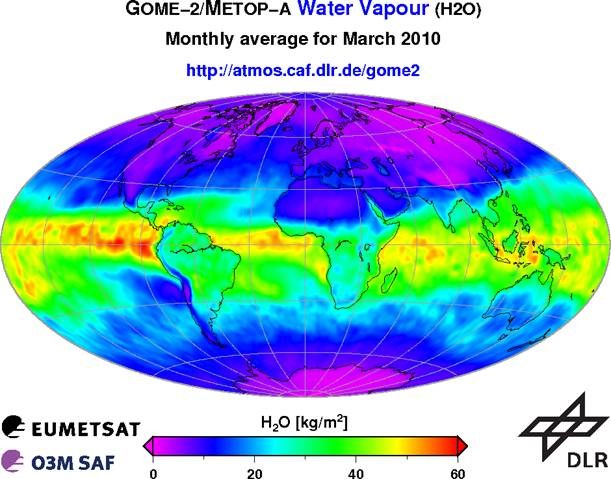Metop-A measures global water vapour and formaldehyde
The Global Ozone Monitoring Experiment-2 (GOME-2), the scanning spectrometer on board EUMETSAT’s Metop-A polar-orbiting satellite, is now delivering operational information on the total amount of water vapour and formaldehyde.
Atmospheric water vapour (H2O) is the most important natural (as opposed to man-made) greenhouse gas, accounting for about two-thirds of the natural greenhouse effect. Despite this importance, its role in climate and its reaction to climate change are still difficult to assess. Many details of the hydrological cycle are poorly understood, such as the process of cloud formation and the transport and release of latent heat contained in the water vapour. In contrast to other important greenhouse gases like carbon dioxide (CO2) and methane, water vapour has a much higher temporal and spatial variability. Global monitoring of H2O by Metop-A is therefore a key to understanding its impact on climate.

Formaldehyde (HCHO) is one of the most abundant hydrocarbons in the atmosphere and is an important indicator of so-called non-methane volatile organic compound (NMVOC) emissions and photochemical activity. As such, it is an indicator of the presence of volatile organic compounds in the atmosphere, which in turn play an important role in the formation of toxic ozone close to the surface and also have an important influence on climate through the formation of large aerosol particles. HCHO is a primary emission product from biomass burning and fossil fuel combustion, but its principle source in the atmosphere is the photochemical oxidation of methane and non-methane hydrocarbons. Metop-A measurements of HCHO can be used to constrain NMVOC emissions in current state-of-the-art chemical transport models used in the forecasting and analysis of pollution events and also in modelling climate change.

Operational GOME-2 H2O and HCHO data are being produced by the Deutsches Zentrum für Luft- und Raumfahrt (DLR), the German Aerospace Center, a partner of EUMETSAT’s Ozone and Atmospheric Chemistry Monitoring SAF (O3M-SAF) coordinated by the Finnish Meteorological Institute. The H2O and HCHO retrieval algorithms for GOME-2 have been developed by the Max Planck Institute for Chemistry in Mainz, Germany, and the Belgian Institute for Space Aeronomy (BIRA/IASB) in Brussels, respectively.
GOME-2 H2O and HCHO as well as other operational products can be ordered via the O3M-SAF. DLR provides near-real-time and historical maps of GOME-2 total column (ozone, nitrogen dioxide, tropospheric nitrogen dioxide, bromine oxide, sulphur dioxide, H2O, HCHO) and cloud products on the Internet.
